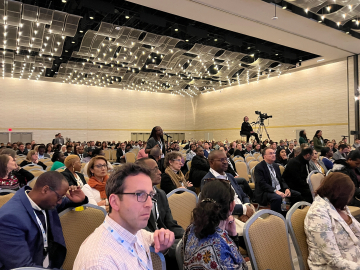Ending Homelessness is Possible. Here’s How We’re Doing It
If you asked them, I suspect most Americans would say that the number of people sleeping in shelters and outside on the streets just keeps multiplying. But recent progress has shown that homelessness is not the intractable problem many people think it is.
Over the last five years, the US has reduced homelessness—both sheltered and unsheltered—across the populations counted by communities every January and reported to the US Department of Housing and Urban Development. Among veterans in particular, the US has reduced homelessness by 47%. And there are now 56% fewer veterans sleeping outside in our parks and on our streets.
The lessons we are learning from that work are shaping our understanding of how we can solve homelessness for everybody, even as rising housing costs continue to put many Americans at risk for experiencing homelessness. Indeed, as many as 7.7 million American households are struggling to pay their rent, and some will lose that housing for short or long stretches.
In that regard, the US is not alone. Places like Australia, Canada, and much of Europe have seen rising housing prices that make it harder for individuals and families to stay stably housed.
It’s not enough to say that the solution to homelessness, both here and abroad, is housing. Getting housing to the people who really need it isn’t so easy, and the biggest challenges have to do with collective will, accountability and systemic change. Here’s what we’ve learned about what else it takes to work toward ending homelessness:
First, people in national, provincial or state-level, and local government with the authority to make change need to publicly commit to it. At the encouragement of First Lady Michelle Obama, more than 880 US governors, mayors, and other elected officials across 45 states, Puerto Rico, and Washington, DC, publicly took up the challenge to end veteran homelessness by 2015. That challenge has driven – and continues to drive—urgent action in communities across the country. Not all of the communities have reached the goal yet, but 30 communities and 2 states have, giving us the proof we need that ending homelessness for veterans and other people is possible.
Second, for a nation to end homelessness, it needs clear goalposts — and broadly-shared accountability. Ending homelessness for a single person is pretty easy to grasp, but it’s much harder to define and measure what an end to homelessness means for a community, or a state, or a country. Last year, the federal government came together and created a single, unified set of criteria and benchmarks for ending Veteran homelessness so that communities know what they are driving toward, and who needs to be part of the work to get there. Criteria and benchmarks for ending chronic homelessness were released this year, and similar measures for families and youth are expected soon.
Third, systems need to work together. In the US, our social services are organized into separate systems—the child welfare system, the workforce system, the school system, the healthcare system—and they think and act systemically. In order for those systems to understand and play the roles we need them to play in ending homelessness, our previous patchwork of outreach, shelter, and housing programs in this country is being reorganized into a system as well—a crisis response system that can quickly identify people experiencing homelessness and get them back into housing and connected to all the other systems they need to stay stable.
There’s no doubt that we have a lot of work to do to reach our goal of ending homelessness for everyone in America. Housing affordability is still a huge problem, and structural change is painstaking work. But the progress we’ve seen just over the last five years should change the minds of those who thought homelessness couldn’t end in our lifetime. It can, and it will.
Jennifer L. Rich is the Director of Communications at the U.S. Interagency Council on Homelessness.
Join the thousands of subscribers who rely on Global Health NOW summaries and exclusive articles for the latest public health news. Sign up for our free weekday enewsletter, and please share the link with friends and colleagues: Subscribe to GHN
A homeless man sits under shelter at Pireus Harbour, Athens, Greece. © 2014 Aimilios Kabrizef/Photoshare




